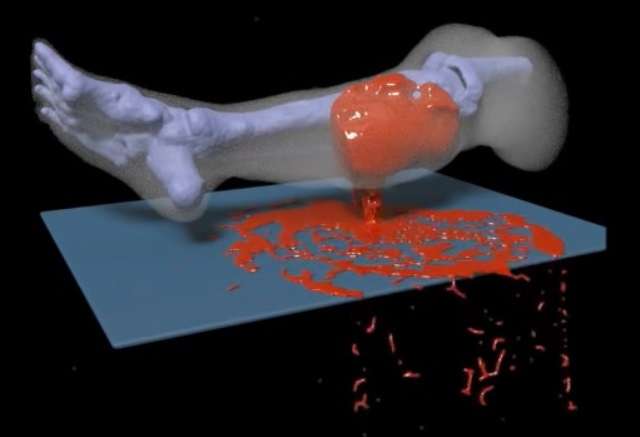Blood work: Technology simulates how legs bleed

To make training for combat medics more realistic, researchers at the University of California Los Angeles (UCLA) have designed the first detailed computer simulation model of an injured human leg—complete with spurting blood.
Sponsored by the Office of Naval Research (ONR), the simulator was created at UCLA's Center for Advanced Surgical and Interventional Technology (CASIT). The research team included surgeons, fluid dynamicists, biomedical engineers, mathematicians and psychologists.
"This model truly is a breakthrough in how combat medics can be taught to control hemorrhaging," said Dr. Ray Perez, a program officer in ONR's Warfighter Performance Department. "Leg injuries are particularly difficult to treat since different points of entry cause different levels of blood loss. This new simulator model can better prepare medics with various ways to staunch bleeding."
The goal of the simulator is to provide future medics with a virtual patient that reacts in realistic fashion to leg wounds. Although previous work has measured blood fluid dynamics and the impact of gunshot and shrapnel wounds to different parts of the body, this is the first such modeling for legs.
Legs, which are rich in blood vessels, are particularly vulnerable places to be injured. Bullets or shrapnel can slice through veins and arteries, resulting in lost limbs or even death. Another threat is damage caused by improvised explosive devices, roadside bombs or mines.
To create the simulator model, researchers combined detailed knowledge of anatomy with real-life CAT scans and MRIs to map out layers of a human leg—the bone, the soft tissue containing muscle and blood vessels and the skin surrounding everything. Then the design team applied physics and mathematical equations, fluid dynamics, and pre-determined rates of blood flow from specific veins and arteries to simulate blood loss for wounds of varying sizes and severity.
"This simulator is unique because it uses mathematics and fluid physics to replicate blood flow," said Dr. Erik Dutson, a general surgeon and CASIT's executive medical director, who oversaw the simulator's design. "Other simulators provide a less detailed, more cartoonish picture of blood flow. We worked with experts in fluid dynamics to create an accurate, realistic vision of the speed and distribution of blood loss."
Dutson envisions the simulator being used in real-time training exercises by combat medics. It would enable them to test different methods of staunching blood flow to perform more effectively in actual battlefield situations. Even better, Dutson said, medics could change the size and shape of virtual wounds—as well as the speed and amount of blood flow—and complete exercises multiple times to improve proficiency.
The CASIT team also designed the simulator to reflect the latest breakthroughs in the science of learning—targeting how the human brain best processes information, adapting to an individual's learning proficiencies, and accelerating learning time and retention during training.
While Dutson is pleased with the simulator's design, his team already is planning improvements—chiefly, enhancing the liquid model representing blood.
"As it stands, the liquid model is similar to water in its composition," he said. "We eventually want to have it mirror more closely the physiological characteristics of blood, which is a living tissue. These include red and white blood cells, plasma, and platelets and clotting properties. We feel we'll get to that level of accuracy soon."
Perez said talks are underway with the Navy and Marine Corps to test the simulator on a trial basis among combat medic recruits.
"Dr. Dutson and his team have created an ambitious suite of technologies serving a major need for the military," said Perez. "We look forward to helping him get this in the hands of combat medics."


















